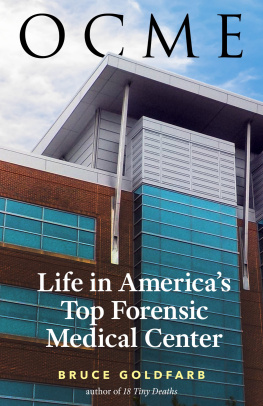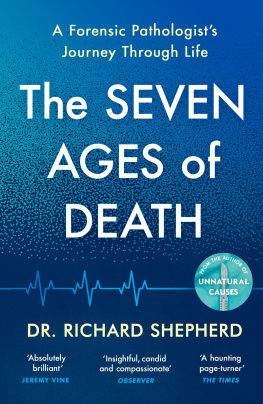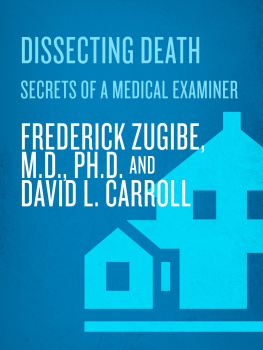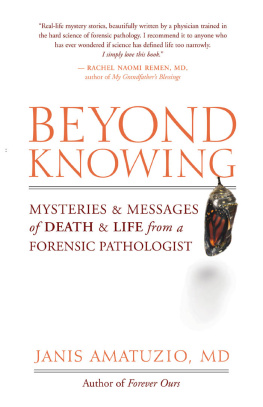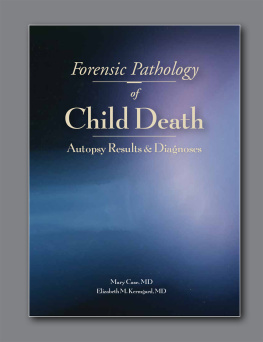To Rutka, Tom & Rita,
and in memory of Frank Cimerol
and Dr. Menachem Melinek
This Can Only End Badly
Remember: This can only end badly. Thats what my husband says anytime I start a story. Hes right.
So. This carpenter is sitting on a sidewalk in Midtown Manhattan with his buddies, half a dozen subcontractors in hard hats sipping their coffees before the morning shift gets started. The remains of a hurricane blew over the city the day before, halting construction, but now its back to business on the office tower theyve been building for eight months.
As the sun comes up and the traffic din grows, a new noise punctures the hum of taxis and buses: a metallic creak, not immediately menacing. The creak turns into a groan, and somebody yells. The workers cant hear too well over the diesel noise and gusting wind, but they can tell the voice is directed at them. The groan sharpens to a screech. The men look upthen jump to their feet and sprint off, their coffee flying everywhere. The carpenter chooses the wrong direction.
With an earthshaking crash, the derrick of a 383-foot-tall construction crane slams down on James Friarsons head.
I arrived at this gruesome scene two hours later with a team of MLIs, medicolegal investigators from the New York City Office of Chief Medical Examiner. The crane had fallen directly across a busy intersection at rush hour and the police had shut it down, snarling traffic in all directions. The MLI driving the morgue van cursed like a sailor as he inched us the last few blocks to the cordon line. Medicolegal investigators are the medical examiners first responders, going to the site of an untimely death, examining and documenting everything there, and transporting the body back to the city morgue for autopsy. I was starting a monthlong program designed to introduce young doctors to the world of forensic death investigation and had never worked outside a hospital. Doc, the MLI behind the wheel said to me at one hopelessly gridlocked corner, I hope you dont turn out to be a black cloud. Yesterday all we had to do was scoop up one little old lady from Beth Israel ER. Today, we get this clusterfuck.
Watch your step, a police officer warned when I got out of the van. The steel boom had punched a foot-deep hole in the sidewalk when it came down on Friarson. A hard hat was still there, lying on its side in a pool of blood and brains, coffee and doughnuts. I had spent the previous four years training as a hospital pathologist in a fluorescent-lit world of sterile labs and blue scrubs. Now I found myself at a windy crime scene in the middle of Manhattan rush hour, gore on the sidewalk, blue lights and yellow tape, a crowd of gawkers, grim cops, and coworkers who kept using the word clusterfuck.
I was hooked.
How did it happen? my husband, T.J., wanted to know when I got home.
The crane crushed his head.
He winced. I mean, how come it toppled over? We were at the small playground downstairs from the apartment, watching our toddler son, Danny, arrange all of the battered plastic trucks and rusty tricycles in a line, making a train.
The crane was strapped down overnight because of the hurricane warning yesterday. The operator either forgot or never knew, and I guess he didnt check it. He started the engine, pushed the throttle, and nothing happened. So he gunned itand the straps broke.
Oh, man, T.J. said, rubbing his forehead. Now its a catapult.
Exactly. The crane went up, hung there for a secondand crumpled over itself backwards.
Jesus. What about the driver?
What do you mean?
Was the crane driver hurt?
Oh. I dont know.
Well, what about the other workers?
I dont know, I repeated. None of them were dead.
T.J. was looking off into the trees. Where did this happen?
I told you, on Sixth Avenue.
And what?
I dont remember! What does it matter? Youre going to avoid that corner because a crane could drop on your head?
Well?
It doesnt happen that often, believe me. Our raised voices had drawn the attention of the other parents on the bench.
Civilians, T.J. warned under his breath, reminding me that no one on a playground full of preschoolers wanted to hear our discussion of a grisly workplace accident. Did he have a wife, kids? he asked quietly.
He had a wife. I dont know about kids.
My husband looked at me askance.
Look, I dont deal with these things! The investigators take care of all that. I only have to worry about the body.
Okay. So tell me about the body.
As part of my medical school training I had done autopsies beforebut they were all clinical, patients who had died in the hospital. I had never seen a corpse like this one. We had to do a full autopsy because its a workplace accident. It was amazing. He was a big guy, muscular. No heart disease, vessels clean. Not a scratch on his limbs or torsobut his head looked like an egg you smash on the counter. We even call it an eggshell skull fracture. Isnt that cool?
No, T.J. replied, suddenly ashen. No, it isnt.
Im not a ghoulish person. Im a guileless, sunny optimist, in fact. When I first started training in death investigation, T.J. worried my new job would change the way I looked at the world. He feared that after a few months of hearing about the myriad ways New Yorkers die, the two of us would start looking up nervously for window air conditioners to fall on our heads. Maybe wed steer Dannys stroller around sidewalk grates instead of rolling over them. We would, he was sure, never again set foot in murderous Central Park. Youre going to turn me into one of those crazy people who leaves the house wearing a surgical mask and gloves, he declared during a West Nile virus scare.
Instead, my experience had the opposite effect. It freed meand, eventually, my husband as wellfrom our six oclock news phobias. Once I became an eyewitness to death, I found that nearly every unexpected fatality I investigated was either the result of something dangerously mundane, or of something predictably hazardous.
So dont jaywalk. Wear your seat belt when you drive. Better yet, stay out of your car and get some exercise. Watch your weight. If youre a smoker, stop right now. If you arent, dont start. Guns put holes in people. Drugs are bad. You know that yellow line on the subway platform? Its there for a reason. Staying alive, as it turns out, is mostly common sense.
Mostly. As I would also learn at the New York City Office of Chief Medical Examiner, undetected anatomical defects do occasionally cause otherwise healthy people to drop dead. One-in-a-million fatal diseases crop up, and New York has eight million people. There are open manholes. Stray bullets. There are crane accidents.
I dont understand how you can do it, friendseven fellow physicianstell me. But all doctors learn to objectify their patients to a certain extent. You have to suppress your emotional responses or you wouldnt be able to do your job. In some ways its easier for me, because a dead body really is an object, no longer a person at all. More important, that dead body is not my only patient. The survivors are the ones who really matter. I work for them too.
I didnt start off wanting to be a forensic pathologist. You dont say to yourself in second grade, When I grow up, I want to cut up dead people. Its not what you think a doctor should do. A doctor should heal people. My dad was that kind of doctor. He was the chief of emergency room psychiatry at Jacobi Medical Center in the Bronx. My father instilled in me a fascination with how the human body works. He had kept all his medical school textbooks, and when I started asking questions he would pull those tomes off their high shelf so we could explore the anatomical drawings together. The books were explorers charts, and he moved with such ease over them, with such assurance and enthusiasm, that I figured if I became a doctor I could sail those seas with him.


